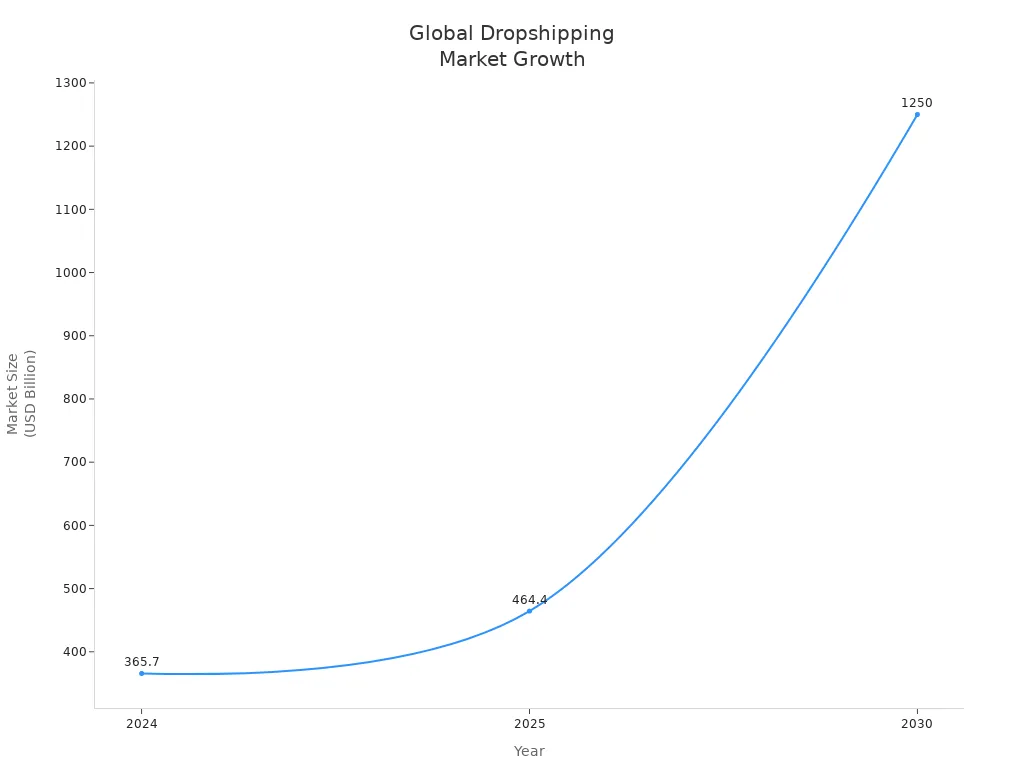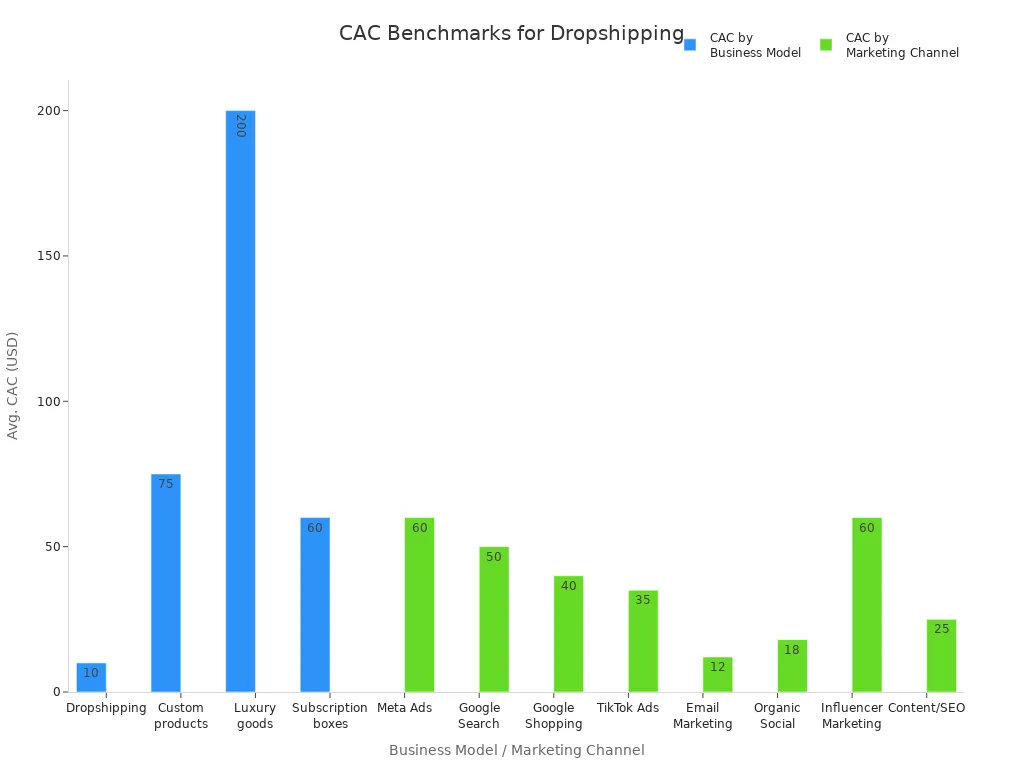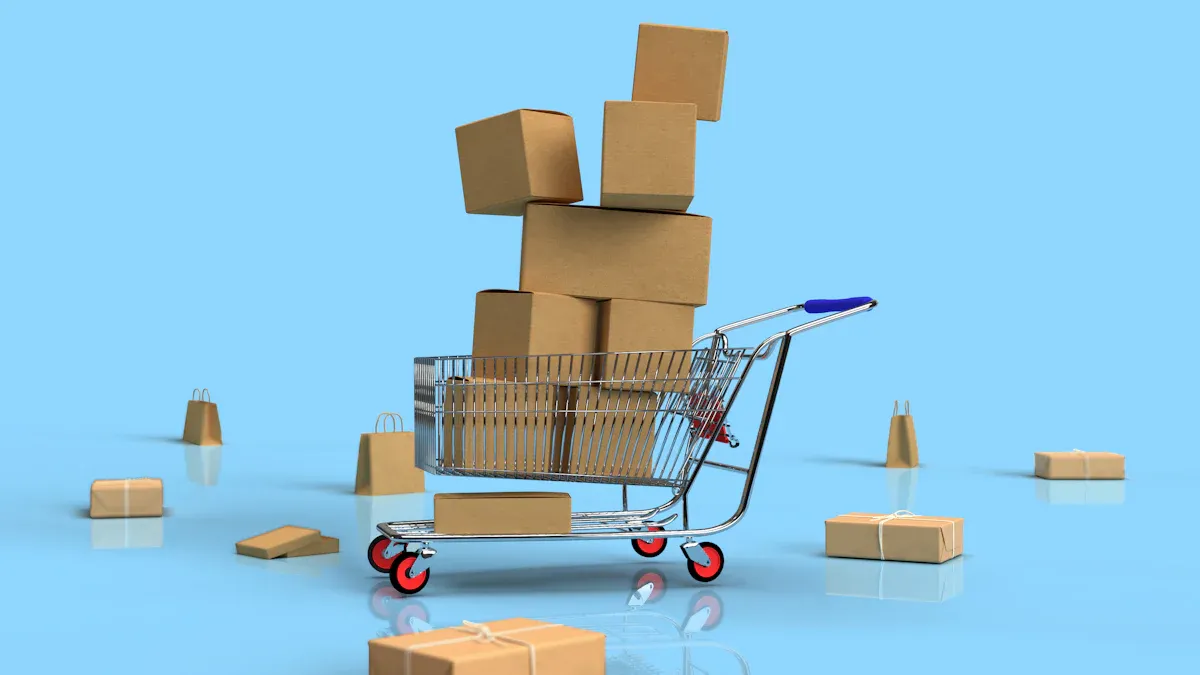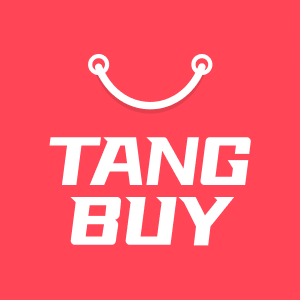High-Performance Dropshipping Strategies for Success in 2025

You want your shop to be special in dropshipping today. High-Performance Dropshipping means you send orders fast. You work with suppliers you can trust. You sell top quality products. The market is growing bigger every year. Look at this chart to see how dropshipping is growing around the world:

You need smart technology to help you. You use real-time analytics to check your progress. You try to get better every day. If you do these things, your dropshipping business can do well in 2025.
Key Takeaways
Work with good suppliers who send orders quickly and always have products. This helps keep your customers happy.
Try to sell expensive or special products. This can help you make more money and build a strong brand.
Use automation tools to help with orders and stock updates. These tools also help you answer customers fast.
Watch important numbers like how much money you make and spend. Check how fast you send orders and how much it costs to get new customers. This helps you make your shop better.
Make your online shop easy to use. Use clear pictures, fast pages, and a simple checkout. This helps stop people from leaving their carts.
Show real reviews and clear shipping details. Use professional branding to help people trust your shop.
Talk often with your team and suppliers. This helps fix problems fast and keeps your business working well.
Keep learning and try new ideas. Use data to help your dropshipping business grow in 2025.

High-Performance Dropshipping Overview
What It Means
High-Performance Dropshipping is not just about selling products online. You use smart tools and automation to make your shop run smoothly. Platforms like Shopify and WooCommerce help you manage orders, track stock, and ship quickly. You do not need to keep products in your own warehouse. Instead, you work with suppliers who send items straight to your customers. Sometimes, you mix in-house fulfilment for your best-selling products with dropshipping for the rest. This hybrid approach gives you more control over quality and speed. You can scale your business fast without spending lots of money on stock or storage.
Why It Matters
You might wonder why you should care about High-Performance Dropshipping in 2025. The answer is simple. The dropshipping market keeps growing. It is set to reach over $370 billion in 2025. Dropshipping now makes up almost a quarter of all online sales. You can start with low costs and little risk. You do not need to buy lots of products upfront. Automation tools let you handle many orders at once. You can run your business from anywhere. You can reach customers all over the world. If you focus on niche markets and offer unique or high-value products, you stand out from the crowd. Meeting customer needs for fast shipping and clear updates helps you build trust and get repeat sales.
Tip: Use automation and data tools to track your sales and spot trends early. This helps you stay ahead of your competition.
Key Factors
To succeed with High-Performance Dropshipping, you need to focus on a few key things:
Work with reliable suppliers who ship fast and keep products in stock.
Choose high-ticket or unique products that give you better profit margins.
Build a strong brand so customers remember you and trust your shop.
Use third-party logistics (3PL) partners for quick and smooth delivery.
Keep your pricing fair and clear. Adjust prices when the market changes.
Optimise your checkout process to make buying easy and reduce abandoned carts.
Stay flexible. Switch suppliers or products if you spot problems or new trends.
Use data to guide your marketing and improve your service.
Here is a quick table to help you remember what matters most:
Key Factor | Why It Matters |
|---|---|
Fast Fulfilment | Keeps customers happy |
High-Ticket Items | Increases your profits |
Reliable Suppliers | Reduces delays and errors |
Strong Branding | Builds trust and loyalty |
Smart Automation | Saves time and cuts costs |
If you get these basics right, you set yourself up for growth and long-term success.
KPIs

Financial
Revenue
You want to see how much money your shop makes. Revenue means all the sales from every order. Watching revenue helps you find your best-selling products. It also shows which months are busiest. If you check your revenue, you can get ready for busy times. You can also plan for slow months. You will know if new products or marketing ideas work.
Tip: Use your dashboard on Shopify or WooCommerce to check revenue each day and month. Set goals for every quarter and look at them often.
Margins
Margins show how much profit you keep after costs. Gross profit margin is what you make after paying for goods. Net profit margin is what you keep after all costs, like marketing and returns. Most dropshipping shops want a gross margin between 20% and 50%. Margins above 20% are good. If your margins go down, check your prices or find cheaper suppliers.
Here’s a table to help you learn about key financial KPIs and their targets:
KPI Name | Description | Target/Benchmark |
|---|---|---|
Gross Profit Margin | Difference between sales revenue and cost of goods sold. Shows pricing efficiency and profit. | 20%-50% margin |
Average spend per transaction. Helps you spot upselling chances. | N/A | |
Return Rate | Percentage of orders returned. Shows product quality and customer happiness. | Below 5% |
Order Fulfilment Rate | Percentage of orders shipped on time. Keeps customers coming back. | 95%+ |
If you want better margins, try selling bundles or premium products. Always check your costs before you set prices.
Marketing
Acquisition Cost
Customer Acquisition Cost (CAC) shows how much you spend to get each new customer. Add up your marketing spend and divide by new buyers. Keeping CAC low means you get more from your ads. Good dropshipping shops keep CAC under $10. If your CAC goes up, try new ad channels or improve your website.
Here’s a chart showing average CAC by business type and marketing channel:

Email marketing and social posts often cost less than paid ads. Try different channels to see what works best for your shop.
Conversion Rate
Conversion rate shows how many visitors buy from your shop. You want this number to be high. If your conversion rate is low, check your product photos and descriptions. Also look at your checkout process. Small changes, like clearer buttons or faster loading, can help more people buy.
Here’s a table with key marketing KPIs and how to use them:
KPI Name | Definition | Formula | Example / Explanation |
|---|---|---|---|
Customer Acquisition Cost (CAC) | Total cost spent on acquiring customers, including marketing expenses. | CAC = Total marketing expenses / Number of customers acquired | Spending £1,000 on marketing and getting 100 customers means a CAC of £10 per customer. |
Conversion Rate | Percentage of website visitors who buy something. | Conversion Rate = (Total number of buyers / Total number of visitors) × 100 | If 100 out of 2,000 visitors buy, your conversion rate is 5%. |
Return on Ad Spend (ROAS) | Revenue from ads divided by ad cost. | ROAS = Revenue from Ads / Cost of Ads | If you spend £500 on ads and make £2,000 in sales, your ROAS is 4.0. |
Note: Track CAC and conversion rate every week. If you see a drop, test new ads or update your product pages.
Operations

Fulfilment Speed
Fast fulfilment keeps your customers happy. You want orders shipped quickly after someone buys. Most top suppliers ship within one business day. Some offer same-day shipping if you order early. Use order fulfilment time to measure how fast your shop and suppliers work. If you see delays, talk to your supplier or switch to a faster one.
Here’s a table with important operational KPIs:
KPI Name | Definition | Why It Matters |
|---|---|---|
Order Cycle Time | Time from order placement to delivery. | Shows total fulfilment speed. Helps you spot delays and improve customer satisfaction. |
Order Fulfilment Time | Time from order placement to shipment by supplier. | Directly reflects supplier speed. Essential for High-Performance Dropshipping. |
Perfect Order Rate | Percentage of orders shipped without any issues. | Combines accuracy and speed. Shows overall order quality. |
Tip: Use tracking tools to watch fulfilment speed. Share delivery updates with customers to build trust.
Error Rate
Error rate shows how many orders have mistakes, like wrong items or missing products. You want this number as low as possible. High error rates mean refunds and bad reviews. Aim for an order accuracy rate above 99%. If errors happen, check your order process and packing steps. Automated systems can help reduce mistakes.
Fast shipping and high order accuracy are important for High-Performance Dropshipping.
Build strong relationships with suppliers who offer reliable and quick service.
Review customer feedback to spot problems early.
If you track these KPIs and act on them, you can run a smooth shop and keep your customers coming back.
Team
Productivity
You want your team to work well together, even if everyone is in a different place. Good productivity means your team gets things done on time and keeps customers happy. You can measure this with clear goals for each person and the whole team. These goals might be how many orders you process each day, how quickly you answer customer questions, or how well your marketing campaigns perform.
Here are some ways you can keep your team productive:
Set clear goals for each team member. Use tools like ClickUp, Monday.com, or Trello to track tasks and progress.
Check in with your team often. Try weekly video calls or daily stand-ups to see how everyone is doing.
Use real-time feedback. Chat comments or project notes help you fix problems quickly.
Celebrate wins. When someone does a great job, let them know. This boosts morale and keeps everyone motivated.
Keep a handbook for remote work. This helps everyone know what is expected and how to work together.
You can also use simple KPIs to measure productivity. Here is a table with some examples:
KPI Name | What It Measures | How to Use It |
|---|---|---|
Order Fulfilment Time | How fast orders are processed | Track daily and set improvement goals |
Customer Satisfaction | How happy your customers are | Use surveys or reviews |
Campaign ROI | How well your marketing works | Compare spend to sales |
Tip: Use Kanban boards to see what tasks are in progress, done, or need attention. This makes it easy to spot bottlenecks.
Training
Training helps your team learn new skills and do their jobs better. In dropshipping, things change fast. You need to keep your team up to date with new tools, products, and customer needs. Good training also helps new team members feel welcome and ready to work.
Here are some ways to make training work for your remote team:
Write down your policies and daily steps. Use guides with pictures or videos so everyone can follow along.
Pair new hires with experienced team members. Mentoring helps new people learn faster and feel supported.
Check how well training works. Watch how new team members perform and give feedback often.
Offer regular learning chances. Try webinars, online courses, or in-house training sessions.
After big projects, talk about what went well and what could be better. This helps everyone learn and improve.
Keep a handbook with rules and tips for remote work. Update it when things change.
You can measure training success by looking at how quickly new team members get up to speed, how well they follow processes, and how much they improve over time.
Note: When you invest in training, your team becomes more skilled and confident. This leads to better results for your business.
Supplier Management

Selection
Criteria
Picking a good supplier is very important in High-Performance Dropshipping. You want suppliers who help your shop grow and keep customers happy. Here’s a table to show what you should look for when choosing a supplier:
Criterion | Explanation |
|---|---|
Reputation and Reviews | Choose suppliers with good reputations, positive reviews, and high ratings. |
Product Quality | Make sure products meet standards and look nice when they arrive. |
Pricing and Profit Margins | Find suppliers with fair prices so you can earn money. |
Shipping Options and Costs | Pick suppliers who offer fast and cheap shipping. |
Communication and Support | Work with suppliers who reply quickly and give updates. |
Return and Exchange Policies | Look for easy return policies that fit your shop. |
Dropshipping Experience | Experienced suppliers know dropshipping and fix problems fast. |
Detailed Descriptions and Images | Suppliers should give clear product details and good pictures. |
Legal Compliance and Certifications | Make sure suppliers follow rules and have the right certificates. |
Do not choose suppliers who charge monthly fees just to work with you. Always check if they have real business licences and clear contact details. If a supplier asks for strange payments or adds extra charges after you order, be careful. Suppliers who send wrong items or do not ship after payment are not trustworthy.
Vetting
You need to check your suppliers before trusting them with orders. Vetting means making sure a supplier is honest and can deliver what you promise. Here’s how you can do this:
Set clear rules for what you want, like good quality, fast shipping, and helpful service.
Search for suppliers online. Read reviews, ask for references, and look at their websites.
Order samples. Test the products for quality, packaging, and delivery speed.
Tell suppliers exactly what you expect. Share your standards for quality and delivery.
Use technology to track orders and manage stock. Tools like SRM software and supplier lists help you stay organised.
Try a small launch with a few products. Watch how the supplier does and listen to customer feedback.
Sign contracts that explain what each side must do. Include details about delivery, quality, and what happens if things go wrong.
Keep checking supplier performance. Track delivery times, returns, and customer reviews.
Do not use only one supplier. Spread your orders across different suppliers to avoid problems if one lets you down.
Tip: Always order samples before adding a new product to your shop. This helps you spot problems early and keeps customers happy.
Relationships
Communication
Talking well with your suppliers helps your shop run smoothly. You want to set clear rules and fix problems quickly. Speak to your suppliers often and share updates about your sales and plans. If you have a problem, tell them right away so you can fix it together.
Be friendly and polite in your messages.
Reply quickly to questions or changes.
Give suppliers enough time to get ready and ship orders.
Share news so suppliers know what is coming.
Use email, WhatsApp, or Slack to stay in touch.
Building trust and being open helps you work better with suppliers. When you talk well, you get better service and fewer mistakes.
Negotiation
Negotiation helps you get the best deals and terms from suppliers. You want to know what your supplier needs and find solutions that work for both sides. Start with small orders to test if they are reliable. Once you trust the supplier, you can ask for better prices or payment terms.
Ask for discounts if you order a lot.
See if you can get early payment deals or longer payment times.
Talk about special agreements for unique products.
Be patient and keep the conversation friendly.
Ask about extra services like custom packaging or marketing help.
Good negotiation skills help you earn more money and build strong partnerships. When you work together, you get better prices, faster shipping, and priority support.
Note: Use technology to help with negotiations. Platforms like Alibaba, SaleHoo, and Oberlo let you compare suppliers and track deals easily.
High-Ticket Focus

Product Choice
Focusing on high-ticket products can change your dropshipping shop. High-ticket items are expensive things like luxury furniture, electronics, or fitness equipment. Each sale brings in more money, so you do not need as many orders to reach your goals. These products often have less competition, which helps you stand out.
You can build a premium brand that customers trust.
Fewer sales mean less stress and more time for customer service.
Customers expect top quality, so you need to pick products carefully.
Look for products with steady demand and room for premium branding. Use professional photos and work with influencers to build trust.
Risk
High-ticket dropshipping comes with risks. You spend more money upfront on your website, marketing, and supplier deals. Customers expect perfect service and fast delivery. If something goes wrong, you could lose a lot of money.
You might get low profit margins if suppliers charge high prices.
Using only one supplier is risky. If they fail, your shop suffers.
Shipping expensive items needs insurance and careful packaging.
Customers expect quick answers and help if there is a problem.
You can lower these risks by:
Researching and checking suppliers carefully.
Picking reliable shipping with tracking and insurance.
Giving great customer service and clear communication.
Checking demand and profit before you invest in new products.
Tip: Use tools like Google Trends and Meta Audience Insights to find high-demand niches. Always check supplier reliability before you launch a new high-ticket product.
High-Performance Dropshipping works best when you pick the right suppliers, build strong relationships, and focus on quality products. If you follow these steps, you set your shop up for success in 2025.
Performance
Monitoring
You should always check on your suppliers. This helps you find problems early. You can fix them before they hurt your shop. Dashboards and software help you see how fast suppliers ship. They also show if suppliers make mistakes or run out of stock. Watching these numbers tells you which suppliers help your shop. You also see which ones slow you down.
Here are some easy ways to check supplier performance:
Use sites like Alibaba, Oberlo, and Spocket. These show ratings and reviews for each supplier. You can see who does a good job.
Try syncing your stock in real time. This stops you from selling things that are not in stock. Tools like Inventory Source and Spocket update your stock everywhere.
Set up automatic order sending. Your system sends orders to the right supplier. This keeps your shop running well.
Track important numbers like order speed, mistakes, and customer happiness. Dashboards like Tableau or Microsoft Power BI show these numbers quickly.
Keep logs and error alerts. If something goes wrong, you can find out why and fix it fast.
Test your automation rules often. Make sure your stock sync, price changes, and alerts work right.
Here is a table with popular tools and what they do:
Software Name | Key Features | Integration and Pricing Details |
|---|---|---|
Spocket | Access to US/EU suppliers; real-time inventory syncing; branded invoicing | Integrates with Shopify, WooCommerce; plans from $39.99/month |
Inventory Source | Automates product and order syncing; connects 230+ suppliers; order routing | Multi-platform integration; plans start at $99/month |
Zendrop | Automated order fulfilment; private labelling; fast US shipping | Shopify integration; free plan available, paid plans from $49/month |
Tip: Always have backup suppliers ready. If one supplier has a problem, you can switch fast and avoid delays.
Disputes
Sometimes things go wrong. Orders might get lost or arrive broken. Customers might complain about their orders. You need a plan to fix problems quickly and fairly. If you solve problems fast, your customers stay happy. This also keeps your shop’s good name.
Here are some ways to handle disputes with suppliers:
Use sites with supplier ratings and feedback, like Alibaba or Oberlo. These help you pick suppliers who fix problems fast.
Give real-time order tracking and automatic updates. Customers know where their order is and worry less.
Use support on many channels. Answer questions by email, chat, or phone. Fast replies stop small problems from getting worse.
Use chargeback tools like ChargePay. These tools warn you early, spot fraud, and help you fix disputes automatically.
Keep logs and error alerts. If a dispute happens, you can check what went wrong and show proof to your supplier.
Teach your customers with clear FAQs. If customers know what to expect, they complain less.
Here is a table with tools and platforms that help with disputes:
Tool/Platform Type | Examples/Platforms | Key Features and Benefits |
|---|---|---|
Chargeback Management Platforms | ChargePay | Automates chargeback processes; real-time alerts; fraud detection; dispute resolution support. |
Blockchain Platforms | Hyperledger Fabric, IBM Blockchain | Transparent, tamper-proof tracking; smart contracts automate payments; reduces dispute resolution time. |
NLP Chatbots | Dialogflow, IBM Watson Assistant | Automates supplier/customer communication; immediate support; triggers workflow actions. |
Cloud-Based ERP Systems | NetSuite, Odoo, SAP Business ByDesign | Unified supplier collaboration; real-time performance visibility; automated invoice and payment reconciliation. |
Note: If you keep good records and use smart tools, you can fix disputes quickly and keep your shop running well.
You want your dropshipping shop to work without problems. If you check your suppliers and fix disputes well, you build trust with customers and help your shop grow.
Conversion & Retention
Store Optimisation
UX
You want your shop to feel easy and fun to use. When visitors land on your site, they decide in seconds if they want to stay. Good user experience (UX) helps you turn visitors into buyers. Here are some ways you can make your store better:
Use clear, high-quality product images. People shop with their eyes first.
Make your site load fast. Slow pages make people leave.
Keep your shop simple. Use easy menus and clear categories.
Add a search bar with smart features like voice search or image search. This helps people find what they want quickly.
Make sure your shop works well on phones and tablets. Most shoppers use mobile devices.
Show your bestsellers and highlight special deals.
Use big, bright buttons for “Add to Cart” and “Buy Now”.
Write short, catchy product descriptions. Tell people why your product is special.
Place your unique selling points (USPs) where everyone can see them.
Tip: Shops with fast, mobile-friendly designs and smart search tools can see up to 82% more sales.
A simple, smooth shop keeps people happy and makes them want to buy.
Trust
Trust is everything in dropshipping. If shoppers do not trust your store, they will not buy. You can build trust in many ways:
Show real customer reviews and photos on your product pages.
Add trust badges for secure payments and data protection.
Offer free shipping or clear shipping costs. Surprises at checkout make people leave.
Use professional branding. Your logo, colours, and layout should look sharp.
Share clear return and refund policies.
Display contact details and reply quickly to questions.
Show off your store’s best features, like fast delivery or money-back guarantees.
Trust-Building Feature | Why It Matters |
|---|---|
Customer Reviews & UGC | Builds social proof and confidence |
Secure Payment Badges | Shows your site is safe |
Clear Shipping Info | Reduces surprises and worry |
Professional Branding | Makes your shop look reliable |
Easy Returns | Removes risk for the buyer |
Note: Most shoppers trust stores that look professional and share real customer stories. Make your shop feel safe and friendly.
Cart Abandonment
Checkout
Cart abandonment is a big problem for every online shop. Nearly 70% of shoppers leave without buying. You can fix this by making checkout simple and stress-free.
Keep checkout short. Use as few steps as possible.
Let people buy as guests. Do not force them to make an account.
Offer many payment options, like PayPal, credit cards, and Apple Pay.
Show all costs upfront. Hidden fees make people quit.
Use clear, bold buttons for each step.
Make sure your checkout works well on mobile devices.
Add trust badges and security logos to reassure buyers.
Show delivery times and shipping options clearly.
Tip: Complicated checkouts and surprise costs are the top reasons people leave. Make it easy and honest, and you will see more sales.
Remarketing
Sometimes, people fill their carts but do not finish buying. You can bring them back with smart remarketing:
Send friendly reminder emails about their cart.
Offer a small discount or free shipping to encourage them.
Use retargeting ads on social media to remind them of your products.
Show reviews or testimonials in your emails to build trust.
Make it easy for them to return to their cart with one click.
Did you know? Retargeting ads and cart recovery emails can help you win back many lost sales. Even a simple reminder can make a big difference.
A smooth checkout and clever remarketing help you turn more visitors into happy customers.
Data Use
Testing
You want your shop to work better every day. Data-driven testing helps you find out what works and what does not. You can use A/B testing to compare two versions of a page or feature. For example, you might show one group of visitors a blue “Buy Now” button and another group a green one. You see which button gets more clicks. Multivariate testing lets you test many changes at once, like different headlines, images, and prices. This method works best if your shop gets lots of visitors.
Here are some things you can test in your dropshipping store:
Product page designs
Headline styles and product descriptions
Product image types
Pricing strategies
Call-to-action button colours and text
Where you show shipping times (on product pages or at checkout)
Testing helps you spot what makes people buy. You can use tools like Google Optimize, VWO, or Optimizely. These tools make it easy to set up tests and track results. Always set a clear goal before you start. Maybe you want more people to finish checkout or spend more per order. Test one thing at a time if you want clear answers. Write down your results so you remember what worked.
Tip: Make sure your test runs long enough to get real results. Quick tests can give you the wrong idea.
Feedback
Listening to your customers is just as important as testing. Feedback shows you what people like and what they do not. You can collect feedback from reviews, complaints, refunds, and even cancelled orders. This information helps you fix problems fast.
Here’s how feedback can help your shop:
Find out why customers leave or return products
Spot pain points in your checkout or delivery process
Improve your customer service
Learn what products people want more of
You can use surveys, review requests, or even live chat to gather feedback. Look for patterns in what people say. If many customers complain about slow shipping, you know it is time to talk to your supplier. If people love a certain product, you can promote it more.
Data from testing and feedback helps you make smart choices. You can change your shop quickly when you see a problem. You also use this data to set goals and measure success. Key numbers like conversion rate, average order value, and repeat customer rate show if your changes work. When you use data well, you build a shop that grows and keeps customers happy.
Note: Reliable data lets you plan ahead, spend your money wisely, and keep improving your shop.
Automation & Tech

Automation
Orders
You want your dropshipping shop to work well. Automation helps you do this. Order automation tools save you time. They also stop mistakes from happening. These tools keep your stock and prices up to date. Orders go straight to suppliers. Customers get updates about shipping. You do not need to check every order yourself. This lets you spend more time growing your business.
Here’s a table with top automation tools for orders and support:
Tool | Key Features | Why Choose |
|---|---|---|
Oberlo | Product import automation, real-time syncing, order tracking, custom descriptions | Saves time, seamless Shopify integration, reliable supplier network |
Inventory Source | Automated product data syncing, supplier integrations, order fulfilment automation | Comprehensive data automation, increased efficiency, supplier flexibility |
Shopify Flow | Triggers & actions for orders and inventory, personalised workflows, visual builder | Deep Shopify integration, flexible automation, streamlines operations |
Zapier | Connects 2000+ apps, multi-step workflows, triggers and actions, customisable automation | No coding needed, seamless integrations, scalable, boosts productivity |
You can set these tools to send orders and update stock. They can also change prices for you. This keeps your shop quick and free from errors.
Support
Customer support matters as much as order processing. You want to answer questions fast and keep shoppers happy. Automation tools like Zendesk and Gorgias help with this. They put all messages in one place. It does not matter if it is email, chat, or social media. Chatbots can reply right away, even at night. These tools sort messages so urgent ones get fixed first.
Zendesk gives you a knowledge base and custom workflows. Gorgias works with Shopify and BigCommerce. It helps you track orders and reply quickly. You can set up automatic replies for common questions. This saves time and makes customers feel important.
Tip: Automated support means you always answer messages. Happy customers come back and tell their mates.
Analytics
Reporting
You need to know what is happening in your shop. Analytics tools show sales, customer behaviour, and supplier performance. Real-time data helps you spot problems early. You can fix them before they get worse. Dashboards let you track key numbers like sales, returns, and delivery times.
Advanced visualisation tools turn hard data into easy charts and reports.
Multi-channel data shows how customers find your shop and why they buy.
Supplier analytics help you pick the best partners by tracking shipping speed and product quality.
Forecasting
Forecasting helps you plan ahead. Predictive analytics guess demand, spot trending products, and set good prices. Big data and AI tools show what customers might want next. You can change your stock and marketing before trends shift.
Real-time analytics let you react quickly to changes.
AI-powered forecasting helps you stay ahead of others.
Good forecasts mean fewer out-of-stock items and less wasted money.
Note: If you use analytics well, you make smarter choices and grow your shop faster.
Tools
Product Research
Finding good products is key for dropshipping success. You want tools that show what sells and where people want it. AMZScout’s Product Database and PRO AI Extension help you find ideas using Amazon data. You can filter by category, seller count, and avoid crowded markets.
Here’s a table with top product research tools for 2025:
Tool Name | Starting Cost | Key Features and Benefits |
|---|---|---|
Sell The Trend | $39.98/month | AI-powered product discovery, NEXUS Explorer, 1-click fulfilment, website builder |
AliExpress Dropshipping Center | Free | Product performance data, shipping info, best-seller identification |
Niche Scraper | Free/$49.95/month | Unlimited product scrapes, keyword research, store revenue insights |
Dropship Spy | $39/month | 10,000+ top-selling products, ad insights, reliable supplier connections |
Thieve.co | $15/month | Product popularity scores, high-quality images, niche market reports |
Ecomhunt | Free/$23/month | Curated product database, performance tracking, competitor analysis |
SalesSource | $49/month | Browser extensions, 24/7 support, detailed Shopify reports |
These tools help you test products and check market trends. You can use filters and analytics to find items with high potential.
Chatbots
Chatbots make your shop feel lively. They answer questions and help with orders. Chatbots guide customers through checkout. You can set them to reply instantly, even when you are not working. This means customers always get help when they need it. Chatbots also collect feedback and spot common problems. This helps you improve your shop.
Tip: Chatbots make customers happier and give you more time for bigger jobs.
Scalability
Cloud
If you want your dropshipping shop to grow, you need tools that can keep up. Cloud technology makes this possible. You do not have to worry about running out of space or buying new computers. The cloud lets you manage your shop from anywhere. You can add new products, handle more orders, and work with more suppliers without slowing down.
Cloud-based ERP systems help you keep your data accurate. They connect your Shopify store with your inventory and accounting. You can see all your numbers in one place. This makes it easy to spot trends and make smart choices. When you use cloud tools, you can:
Sync your stock and orders in real time.
Automate tasks like order processing and inventory updates.
Use analytics to plan for busy times and avoid running out of products.
Update your shop and systems quickly to stay secure and stable.
Many dropshippers use cloud phones to manage several shops at once. These phones use unique IPs and device IDs. This helps you avoid account problems and keeps your shops safe. Cloud phones also let you run your business 24/7. You can set up order fulfilment, price tracking, and customer service tools to work even when you are asleep. You save money because you do not need lots of physical devices.
Tip: Choose cloud solutions that let you add more users and features as your shop grows. This way, you never hit a wall when your business takes off.
Security
As your shop gets bigger, you must keep your data safe. Customers trust you with their details. You need to protect this information at all times. Good security starts with strong access controls. Only let trusted team members see important data. Make sure your systems follow PCI rules for handling payments.
Here are some best practices for keeping your dropshipping shop secure:
Use unique logins and passwords for each team member.
Turn on anti-tracking features to stop unwanted access.
Set up auto-backups so you never lose your data.
Monitor your shop with dashboards to spot anything strange.
Keep your cloud apps and ERP systems updated for the latest security fixes.
Use cloud phone environments that randomise device fingerprints and protect your store from cross-tracking.
You should also check your systems often. Look for any signs of trouble, like failed logins or strange orders. If you spot a problem, act fast. Regular updates and good habits keep your shop safe as you grow.
Note: When you use cloud technology and follow strong security steps, you can scale your dropshipping business with confidence. Your customers will feel safe, and you can focus on growing your shop.
Team & Process
Hiring
Roles
You want your dropshipping shop to run smoothly. Building a strong team helps you do this. Start by hiring for the most important roles. You need an Operations Manager to keep things organised. A Product Research Specialist finds winning products. An Order Fulfilment Manager makes sure orders go out fast. Customer Support Representatives answer questions and solve problems. These roles cover the main parts of your business.
When your shop grows, you will notice signs that it is time to hire more people. If you see steady revenue growth, lots of repetitive tasks, or sales slowing down because you cannot keep up, it is time to expand your team. Many dropshippers choose remote hiring. This lets you find talented people from anywhere and saves money on office space.
Here is a quick list to help you remember the best hiring strategies:
Hire for key roles first.
Watch for signs that you need more help.
Choose remote hiring to reach more candidates.
Use automation tools like Slack, Trello, Zapier, and Gorgias to boost team efficiency.
Avoid hiring without clear procedures.
Start with part-time or freelance hires if you need to keep costs low.
Onboarding
Bringing new team members onboard should feel easy and welcoming. You want everyone to know what to do from day one. Create detailed onboarding guides with step-by-step instructions. Use scorecards and feedback platforms like Greenhouse or Typeform to check how new hires are doing. These tools help you give fair feedback and keep everyone on track, even if your team works in different time zones.
Set clear remote work policies. Tell your team about work hours, communication tools, and performance goals. Make sure everyone knows how to get tech support and what equipment they need. Highlight your company culture and remote work benefits during onboarding. This helps new hires feel part of the team and understand your values.
Tip: A good onboarding process builds trust and helps new team members work confidently from the start.
Processes
SOPs
Standard Operating Procedures (SOPs) make your shop run like clockwork. SOPs tell everyone what their job is and how to do it. You get fewer mistakes and better results. SOPs also help you track how well your team works and spot areas to improve.
SOPs define roles and responsibilities.
They standardise tasks and remove wasted effort.
You get consistent quality every time.
SOPs help you measure and improve workflow.
Review and update SOPs often to keep them useful.
Workflow
You want your workflow to be smooth and fast. Automate order syncing so orders go straight from your shop to suppliers. Use real-time inventory updates to avoid selling out-of-stock items. Automate tracking updates for customers. This keeps everyone informed and happy.
Use data analysis to find slow spots and fix them. As your shop grows, think about working with third-party logistics providers. They help you ship faster and offer better branding.
Note: Optimised workflows save time, cut costs, and keep your customers coming back.
Culture
Reviews
Regular reviews help your team improve. Give feedback often and celebrate wins. Use structured feedback tools to keep reviews fair and helpful. This keeps everyone motivated and focused on their goals.
Innovation
Encourage your team to share new ideas. Try new tools and test fresh approaches. A culture of innovation helps your shop stay ahead of the competition. When your team feels free to experiment, you find better ways to serve your customers.
Remember: A strong team and clear processes set your dropshipping shop up for success in 2025.
Remote Teams
Communication
You might have team members in different countries or time zones. Good communication keeps everyone on the same page. You want your team to feel connected, even if you never meet in person. Start with clear rules for how and when to talk. Use tools like Slack, Microsoft Teams, or WhatsApp for quick chats. Video calls on Zoom or Google Meet help you see each other and build trust.
Here are some ways to make communication work:
Set daily or weekly check-ins. These meetings help everyone share updates and ask questions.
Use group chats for fast updates. Keep channels organised by topic, like orders, marketing, or support.
Share important news in one place. Pin messages or use a shared document so no one misses out.
Encourage team members to speak up. Let everyone know their ideas matter.
Use emojis and GIFs to make chats friendly and fun. 😊
Tip: Always check if your message is clear. Ask your team to repeat key points to avoid confusion.
A simple table can help you pick the right tools:
Tool | Best For | Extra Features |
|---|---|---|
Slack | Quick team chats | Channels, file sharing |
Zoom | Video meetings | Screen sharing, recording |
Trello | Task tracking | Boards, checklists |
Google Drive | Sharing documents | Real-time editing |
Engagement
You want your remote team to feel part of something bigger. When people feel included, they work harder and stay longer. Start by celebrating wins, big or small. A simple “well done” in the chat can make someone’s day. Share team goals and let everyone see how their work helps the shop grow.
Try these ideas to boost engagement:
Run virtual team games or quizzes. These break the ice and build friendships.
Share photos or stories from your daily life. This helps everyone get to know each other.
Offer rewards for great work. You could give gift cards, extra time off, or public praise.
Ask for feedback often. Let your team suggest new ideas or ways to improve.
Set up a “buddy” system. Pair new hires with experienced team members for support.
Note: Happy teams are productive teams. When you show you care, your team will care about your business.
Keep your remote team connected and engaged. You will see better results and enjoy working together, no matter where you are in the world.
You want your dropshipping shop to be noticed in 2025. Focus on High-Performance Dropshipping by picking popular products and working with suppliers you can trust. Make your shop look neat and professional. Fast fulfilment and selling high-ticket items help you earn more and keep customers pleased. Try these simple strategies:
Show your products with good pictures and clear value.
Create a group on social media and share posts about daily life.
Offer extra items to raise order value and use email to keep in touch.
Try out new ideas, change quickly, and check your results.
Work with influencers and ask customers to leave reviews for trust.
Keep learning new things, watch your numbers, and change your plan when needed. If you stay open-minded and ready to change, your business will grow and your customers will return. 🚀
FAQ
What is high-performance dropshipping?
High-performance dropshipping means you run your shop with speed and accuracy. You use smart tools, work with top suppliers, and focus on quality products. This helps you stand out and grow your business faster.
How do I find reliable suppliers?
You can use trusted platforms like Tangbuy, Spocket, AliExpress, or SaleHoo. Always check reviews and order samples first. Good suppliers reply quickly and ship on time. If you test them, you will know who to trust.
Why should I sell high-ticket items?
High-ticket items give you bigger profits with fewer sales. You spend less time on small orders. You can also build a premium brand. Customers who buy expensive products often expect better service, so you can stand out.
How can I reduce cart abandonment?
Keep your checkout simple and clear. Show all costs upfront. Offer guest checkout and many payment options. Send reminder emails if someone leaves their cart. A smooth process helps more people finish their orders.
What tools help automate my dropshipping shop?
You can try tools like Oberlo, Shopify Flow, and Zapier. These handle orders, update stock, and send tracking info. Automation saves you time and stops mistakes. You can focus on growing your shop.
How do I keep my customers coming back?
Offer great service and fast shipping. Use email to share news and special deals. Start a loyalty programme or give discounts to repeat buyers. Happy customers will return and tell their friends.
Is dropshipping still profitable in 2025?
Yes, dropshipping can still make you money in 2025. You need to pick the right products, use smart tools, and keep improving your shop. If you stay flexible and learn new things, you can succeed.
Tip: Always watch your numbers and listen to your customers. This helps you spot problems early and keep your shop strong.

TangBuy: A Smarter Way to Dropship in 2025
If you're looking to stay competitive with dropshipping in 2025, speed and trend-awareness are key. TangBuy helps you stay ahead with real-time product trends, fast fulfilment, and factory-direct sourcing. With over 1 million ready-to-ship items, 24-hour order processing, and seamless Shopify integration, TangBuy makes it easier to test, scale, and succeed in today's fast-moving eCommerce landscape.
See Also
Profitable Dropshipping Concepts To Explore In 2025
Understanding The Real Expenses Of Dropshipping In 2025
High-Earning Dropshipping Markets To Target In 2025

